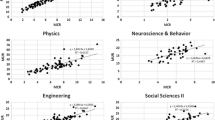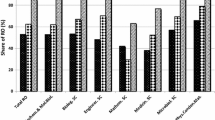Abstract
In this study usage counts and times cited from Web of Science Core Collection (WoS) were collected for articles published in 2013 with Belgian, Israeli and Iranian addresses. We investigated the relations among three indicators related to citation impact, usage counts and co-authorship, respectively. In addition, we applied the method of Characteristic Scores and Scales (CSS) to analyse the distributions of citations and usage counts to further test the relation between the usage and citation impact. The results show that citations and usage counts in WoS correlate significantly, especially in the social sciences. However, higher numbers of co-authors are not associated with higher usage counts or citations. Furthermore, the stability of CSS-class distributions substantiates the applicability of CSS in characterising both usage and citation distributions. Distinctly different patterns in citations and usage are observed, but the similarities within citations and usage in these fields are somewhat unexpected.

[Data sourced from Thomson Reuters Web of Science Core Collection]

[Data sourced from Thomson Reuters Web of Science Core Collection]

[Data sourced from Thomson Reuters Web of Science Core Collection]
Similar content being viewed by others
References
Bollen, J., van de Sompel, H., Hagberg, A., & Chute, R. (2009). A principal component analysis of 39 scientific impact measures. PLoS ONE, 4(6), e6022.
Bornmann, L. (2015). Alternative metrics in scientometrics: A meta-analysis of research into three altmetrics. Scientometrics, 103(3), 1123–1144.
Brody, T., Harnad, S., & Carr, L. (2006). Earlier web usage statistics as predictors of later citation impact. Journal of the American Society for Information Science and Technology, 57(8), 1060–1072.
Chi, P.S. & Glänzel, W. (2016). Do usage and scientific collaboration associate with citation impact? In I. Ràfols, J. Molas-Gallart, E. Castro-Martínez & R. Woolley (Eds.), Proceedings of the 21st international conference on science and technology indicators, València (pp. 1223–1228).
Cronin, B., Shaw, D., & La Barre, K. (2004). Visible, less visible, and invisible work: Patterns of collaboration in 20th century chemistry. Journal of the American Society for Information Science and Technology, 55(2), 160–168.
Glänzel, W. & Heeffer, S. (2014). Cross-national preferences and similarities in downloads and citations of scientific articles: A pilot study. In E. Noyons (Ed.), Proceedings of the STI Conference 2014, Leiden (pp. 207–215).
Glänzel, W., & Schubert, A. (1988). Characteristic scores and scales in assessing citation impact. Journal of Information Science, 14(2), 123–127.
Glänzel, W., & Schubert, A. (2003). A new classification scheme of science fields and subfields designed for scientometric evaluation purposes. Scientometrics, 56(3), 357–367.
Glänzel, W., & Thijs, B. (2004). Does co-authorship inflate the share of self-citations? Scientometrics, 61(3), 395–404.
Glänzel, W., Thijs, B., & Chi, P. S. (2016). The challenges to expand bibliometric studies from periodical literature to monographic literature with a new data source: The book citation index. Scientometrics, 109(3), 2165–2179.
Glänzel, W., Thijs, B., & Debackere, K. (2014). The application of citation-based performance classes to the disciplinary and multidisciplinary assessment in national comparison and institutional research assessment. Scientometrics, 101(2), 939–952.
Grossman, J. W. (2002). The evolution of the mathematical research collaboration graph. Congressus Numeratium, 158, 202–212.
Hammarfelt, B. (2014). Using altmetrics for assessing research impact in the humanities. Scientometrics, 101(2), 1419–1430.
Moody, J. (2004). The structure of a social science collaboration network: Disciplinary cohesion from 1963 to 1999. American Sociological Review, 69(2), 213–238.
Persson, O., Glänzel, W., & Danell, R. (2004). Inflationary bibliometric values: The role of scientific collaboration and the need for relative indicators in evaluative studies. Scientometrics, 60(3), 421–432.
Peters, H. P. F., & van Raan, A. F. J. (1994). On determinants of citation scores: A case study in chemical engineering. Journal of the American Society for Information Science and Technology, 45(1), 39–49.
Pringle, J. (2015). The Web of Science Usage Count. Retrieved from http://thomsonreuters.com/content/dam/openweb/documents/pdf/scholarly-scientific-research/white-paper/web-of-science-usage-count-report.pdf on December 6, 2016.
Sonnenwald, D. H. (2007). Scientific collaboration. Annual Review of Information Science and Technology, 41(1), 643–681.
Wang, X., Fang, Z., & Sun, X. (2016). Usage patterns of scholarly articles on Web of Science: A study on Web of Science usage count. Scientometrics, 109(2), 917–926.
Acknowledgements
This paper is an extended version of a previous work presented at the 21st STI Conference in Valencia, Spain (Chi and Glänzel 2016).
Author information
Authors and Affiliations
Corresponding author
Rights and permissions
About this article
Cite this article
Chi, PS., Glänzel, W. An empirical investigation of the associations among usage, scientific collaboration and citation impact. Scientometrics 112, 403–412 (2017). https://doi.org/10.1007/s11192-017-2356-4
Received:
Published:
Issue Date:
DOI: https://doi.org/10.1007/s11192-017-2356-4




